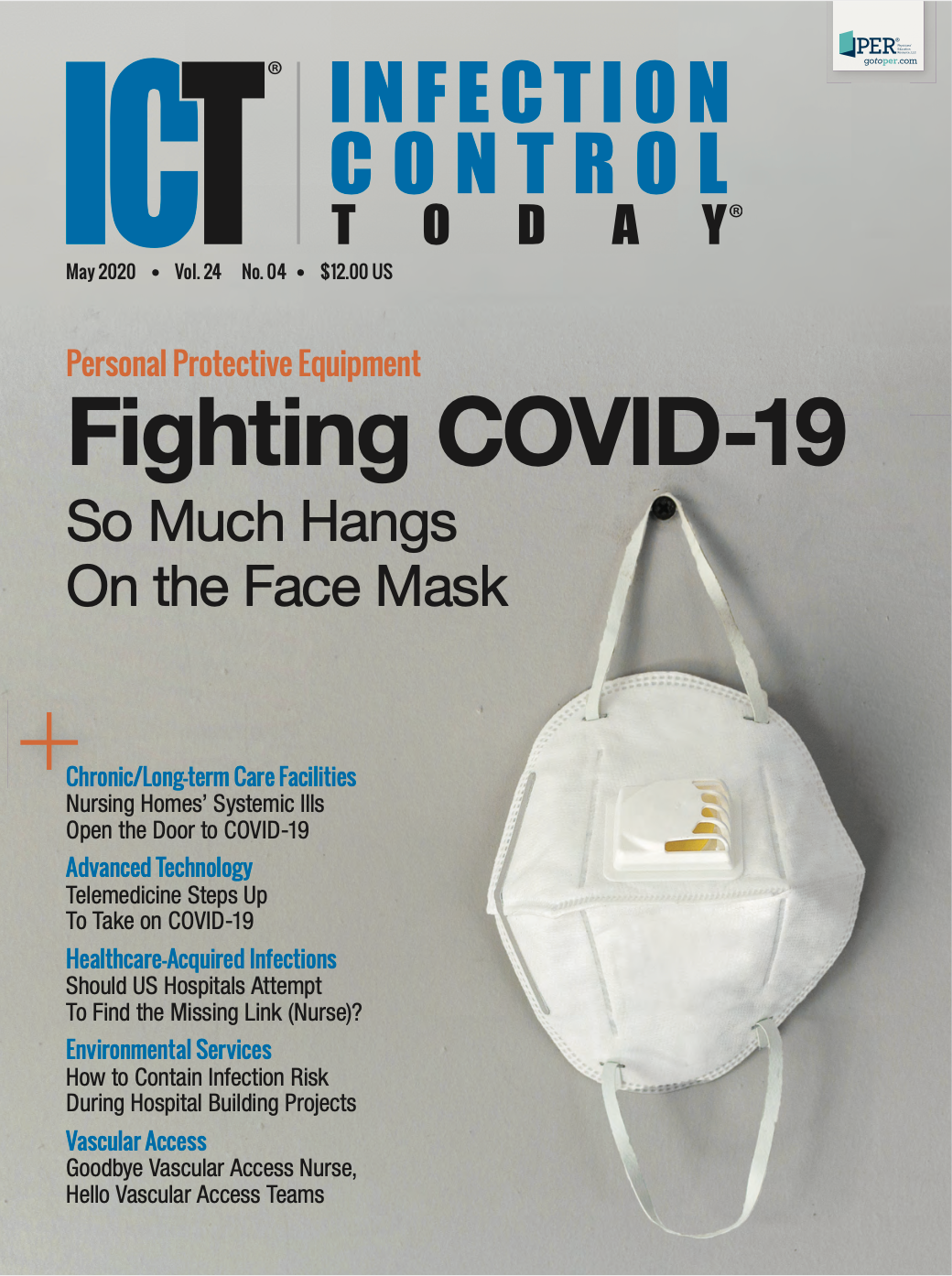Searching for the Missing Link (Nurse)
Ideally, link nurses increase awareness of infection control issues and motivate colleagues to improve in that regard, keeping patients and themselves safer by limiting the spread of HAIs.

A lot of it comes down to education and communication. That’s the primary takeaway from a studyin Antimicrobial Resistance & Infection Control1saying that the effectiveness of link nurses in helping to bolster infection prevention and control (IPC) efforts very much depends on the support those nurses and the programs they’re associated with have from hospital management, and the quality of interaction between link nurses and infection control personnel.
A link nurse is a professional more common in Europe; in the United States they’re sometimes referred to as “nursing infection control champions,” according to Saskia v. Popescu, PhD, MPH, a nationally known infection preventionist and a member of Infection Control Today®’s Editorial Advisory Board. “They are often rare, but they’re a wonderful resource if hospitals can encourage and support link nurse programs,” says Popescu.
Popescu speaks from a wealth of experience, but hard evidence on the effectiveness of link nurses is spotty. In January 2019, ICT®reportedon a study that concluded that there’s just not enough data to determine how well link nurse programs work. The authors of that studyconcluded that “available studies have methodological issues, small sample size or lack the consideration of the implementation process or patient outcomes.”2
That study was also published in Antimicrobial Resistance & Infection Controland both studies have the same corresponding author, Mireille Dekker, of the department of medical microbiology and infection prevention with Amsterdam UMC, Vrije Universiteit Amsterdam. Last year’s study-January 2019-was titled “Infection Control Link Nurses in Acute Care Hospitals: A Scoping Review.”
Dekker tells ICT®: “I am indeed on a bit of a mission to study the effects of link nurse programs and ways to improve their impact. I started out as a link nurse myself. Nowadays, I am a clinical epidemiologist working in infection control. In our hospital, this two-way communication between the infection control team and the nurses in the ward is vital, especially in these hectic times.”
The study published this year in February 2020 was titled “Infection Control Link Nurse Programs in Dutch Acute Care Hospitals: A Mixed-Methods Study.”
It examines ways to make link nurse programs more effective and although it too bemoans the dearth of data about such programs, it suggests ways hospitals can find out more. “To evaluate the contribution of ICLN [infection control link nurse] programs to the implementation of IPC guidelines it is necessary to audit the program effects and to perform well-designed effectiveness studies,” the study states. “Social network analysis could contribute to understanding how knowledge on infection control and prevention is transferred best.”
The link nurse provides just that-a link-between IPC and hospital wards and/or departments. Ideally, they increase awareness of infection control issues and motivate colleagues to improve in that regard, keeping patients and themselves safer by limiting the spread of healthcare-acquired infections (HAI). To be most effective, link nurses need to receive training from the infection control team. Although infection control link nurse programs exist throughout the world, there’s wide variation on how the programs are organized and implemented.
In the study, Dekker and associates write that “the few studies that have evaluated effectiveness of these programs revealed that compliance with hand hygiene guidelines and incidence of MRSA infections indeed improve when ICLN are active. However, these studies do not describe their ICLN program in detail nor elaborate on the contextual factors that may have contributed to these improvements. Contextual factors include factors that are not part of the ICLN program such as cultural, organizational and management characteristics of the hospital, but do play a role in the implementation of IPC practices.”
Nearly 90% of the hospitals made education a bulwark of ICLN efforts. That usually included 2-hour sessions given about 6 times a year. These sessions were conducted in-house.
Dekker and associates collected data through a mixed-methods process combining a survey and semi-structured interviews with infection control practitioners. Seventy-two infection control practitioners from 72 different hospitals participated in the survey (the Netherlands has 74 hospitals).
Investigators also conducted in-depth interviews with 4 of the infection control practitioners. Snippets of these interviews pepper the study and offer a snapshot of the challenges and rewards of ICLN efforts.
The survey was divided into five parts and asked whether their institution had an ICLN program or intended to set one up, what were the tasks of the link nurses, what infection prevention professionals felt ICLNs needed to be able to do a better job, what sort of education was provided and how respondents rated the programs. In the final part of the survey, respondents were asked to what extent they were able to accomplish their IPC goals through the help of ICLN, the study states. This was expressed on a 10-point Likert scale.
Forty-eight (66.7%) completed surveys came from hospitals with an ICLN program; 18 (25%) from hospitals planning to implement one in the near future. Six (8.3%) said that their ICLN programs had been abandoned due to lack of support from the ward and/or hospital management.
The ICLN programs had been in operation from 3 to 8 years in the institutions that had them. In the hospitals where the infection control team initiated the program, the IP teams did so from an effort to disseminate IPC knowledge, and often in response to an infection control problem.
“The actual start of these programs was related to a more positive overall attitude of hospital management and healthcare workers towards IPC; it was sparked by threats such as a recent Ebola outbreak and the rise of antimicrobial resistance,” the study states.
As an interviewee put it, “We needed this outbreak of vancomycin-resistant enterococcito convince our hospital management that we needed to implement an ICLN program” (the interviewees were not identified).
The top 3 goals of the ICLN programs were to increase an awareness of infection prevention, create a liaison between the wards and the IPC team, and to make the ICLN a source of information for peers. “Some infection control practitioners were able to described these program goals in a clear manner and incorporated knowledge and skills from other departments (e.g. quality department, training and education department) to supplement their own and ICLN’ competences whereas others found it challenging to prepare a plan of action,” the study states.
As an interviewee put it, “As an infection control practitioner I am obliged to support link nurses, but I don’t know how to do that best.”
The relationship between the ICLN and the IPC team was give-and-take, but exactly who was giving what and in what amount varied. “Some infection control practitioners focused their efforts on providing support for the ICLN in implementing IPC policies, where others focused more on receiving support from the ICLN in monitoring the compliance with IPC measures,” the study states.
Many times, the programs were created on the run. “Infection control practitioners described that they developed their programs while implementing them at the same time,” the study states. “Programs were adapted as IPC teams searched for an optimum strategy to collaborate with their link nurses to improve practice. Adjustments to the program were based on lessons learned during implementation and the dynamic IPC priorities. Infection control practitioners query what sort of training to provide, what topics to educate on and how to stimulate ICLN to be proactive.”
Communication doesn’t always flow freely. One interviewee said that, “Our link nurse meetings must become a bit more interactive. We need to ask: What did you learn? What will you do differently tomorrow? What is the next issue you will address?”
When it came to making ICLN program goals, the buck stopped with the IPC team in two thirds of the hospitals.
“The IPC teams perceived the introduction of ICLN networks and the activities of ICLN as important assets that helped them to achieve their infection control goals,” the study states. “They scored this importance with a median of 7.0 (IQR 6.0–7.0) on a 10-point Likert scale.”
The study concludes” “Although programs vary widely, education is an overall core component. Efforts to improve the uptake of IPC guidelines through ICLN programs should focus on enhancing infection control practitioners’ and link nurses’ knowledge on implementation science and designing these link nurse programs as multimodal interventions.”
References:
1. Dekker M, van Mansfeld R, Vandenbroucke-Grauls C, De Bruijne M, Jongerden I. Infection control link nurse programs in Dutch acute care hospitals; a mixed-methods study. Antimicrob Resist Infect Control. Published online Feb 27, 2020. doi: 10.1186/s13756-020-0704-2
2. Dekker M, et al. Infection control link nurses in acute care hospitals: a scoping re-view. Antimicrob Resist Infect Control. 2019;8:20

Happy Hand Hygiene Day! Rethinking Glove Use for Safer, Cleaner, and More Ethical Health Care
May 5th 2025Despite their protective role, gloves are often misused in health care settings—undermining hand hygiene, risking patient safety, and worsening environmental impact. Alexandra Peters, PhD, points out that this misuse deserves urgent attention, especially today, World Hand Hygiene Day.
From the Derby to the Decontam Room: Leadership Lessons for Sterile Processing
April 27th 2025Elizabeth (Betty) Casey, MSN, RN, CNOR, CRCST, CHL, is the SVP of Operations and Chief Nursing Officer at Surgical Solutions in Overland, Kansas. This SPD leader reframes preparation, unpredictability, and teamwork by comparing surgical services to the Kentucky Derby to reenergize sterile processing professionals and inspire systemic change.
Show, Tell, Teach: Elevating EVS Training Through Cognitive Science and Performance Coaching
April 25th 2025Training EVS workers for hygiene excellence demands more than manuals—it requires active engagement, motor skills coaching, and teach-back techniques to reduce HAIs and improve patient outcomes.
The Rise of Disposable Products in Health Care Cleaning and Linens
April 25th 2025Health care-associated infections are driving a shift toward disposable microfiber cloths, mop pads, and curtains—offering infection prevention, regulatory compliance, and operational efficiency in one-time-use solutions.